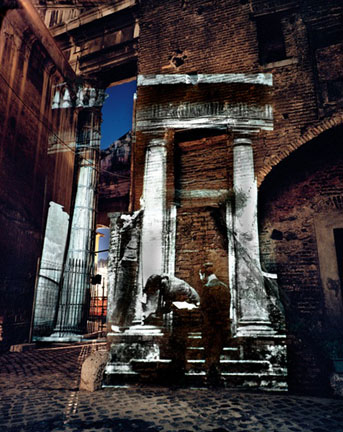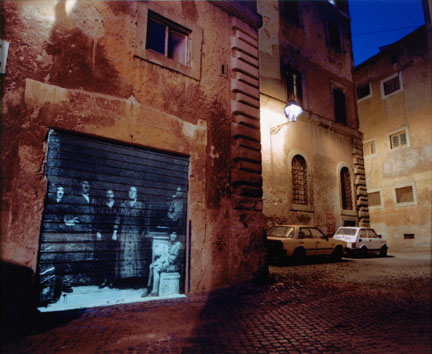About the Photographer
Attie, Shimon
American, b.1957
Concerned with questions of memory, place, and identity, Shimon Attie gives visual form to both personal and collective memories by introducing histories of marginalized and forgotten communities into the physical landscape of the present. "The Writing on the Wall" project (1991-1993) took place in Berlin's former Jewish quarter, the Scheunenviertel neighborhood. There Attie projected slides made from pre-Holocaust photographs of the neighborhood's Jewish residents and shops in the same (or sometimes nearby) locations where the original images were taken. He then photographed the resulting scene. A woman from the past looks out the window of a building now scrawled with graffiti. A pigeon shop with cages stacked on the sidewalk is restored to an otherwise empty street. The life and industry suggested in the projections of the past strike an unexpected counterpoint to the crumbling facades and apparently abandoned places of the present.
Using modern Rome as his backdrop, in "The History of Another" (2001-2002), Attie projected fragments of historical photographs of Roman Jews onto the city's ruins and excavation sites. The resulting pictures conflate three distinct historical moments, that of ancient Rome, Roman Jews at the turn of the century, and modern Rome with its new construction and continual efforts to conserve relics of the past. By projecting historical photographs onto ruins and also including in his frame elements of contemporary Rome, Attie creates an environment in which time becomes visible and compressed rather than invisible and expanding, like our normal perception of time. Dividing our attention carefully between three moments in the human history of this place, he implies that history might not have anything to do with time, but might be better thought of as a continuous, repetitious loop that contains both stone ruins and, less tangible, human presence.
In the film "The Crossing" (2017), a series of slowmoving tableaux unfold featuring seven elegantly dressed young men and women inside a casino engrossed in a game of roulette. The players are Syrian refugees who have recently arrived in Europe, many on rafts over the Mediterranean just weeks before the filming with no prior performing or acting experience. The metaphorical tale that unfolds in the film is based on the participants’ individual experiences of exile and flight. Attie states: “The Crossing uses the language of contemporary art to reflect on the extraordinary risks migrants are forced to take in times of crisis, literally gambling for their lives.” Here we see a depiction of the last survivor of the game.
Born in Los Angeles in 1957, Shimon Attie lived in Europe for seven years before moving to New York in the fall of 1997. He has exhibited widely in both the United States and Europe, including shows at the Institute of Contemporary Art, Boston; the Centre Georges Pompidou, Paris; and the Museum of Modern Art, New York. His work is held in the permanent collections of the Museum of Modern Art, New York; the Berlinische Galerie, Berlin, the Corcoran Gallery of Art, Washington DC, and the Los Angeles County Museum of Art, Los Angeles, CA, among others.




